A single day Summer Tour today, we were looking for birds of prey in the morning and then heading to the coast afterwards. We were lucky with the weather – it was raining early this morning but stopped just as we got out of the car at our first stop, and then we avoided the showers until we got back to the car park at the end of the day!
As we drove to our first destination of the morning, a rather damp Kestrel was perched on some wires by the road in the drizzle. Thankfully we could see blue sky in the west heading our way. A Sparrowhawk zipped across the road and over the hedge the other side. A nice way to start our morning looking for raptors.
We stopped at the bottom of a farm track and walked up to a convenient vantage point from which we could scan the surrounding countryside. A pair of Grey Partridge flew off from the grass as we got out of the car. It was rather cool, not the perfect morning for birds of prey, but after the rain there was still lots of activity, with birds flying around and making the most of the dry weather.
A Common Buzzard was perched in a tree and another circled up over the wood. We saw a Sparrowhawk in the distance and, a little later, one appeared in the top of a dead bush in the hedge at the bottom of the field in front of us. A little while later, it circled up, alternating bouts of flapping with glides, turning in tight circles before heading off towards a nearby wood.
There were other birds besides the raptors. There were lots of Swifts hawking for insects over the fields, gaining height gradually as it started to warm up. A Yellow Wagtail flew over calling – a rare breeder in this part of the world these days. A sharp ‘kik’ call alerted us to a Great Spotted Woodpecker flying overhead. A pair of Stock Doves flew over the field towards us, banking away sharply when they spotted us. A Yellowhammer was singing from the hedge and several Skylarks started to sing and flutter up higher into the sky as the sun came out.
 Skylark – fluttering up over the fields, singing
Skylark – fluttering up over the fields, singing
With our mission accomplished, we made our way back to the car and headed for Titchwell, which was to be our destination for the rest of the day. It was already late morning by the time we got there. We had a quick look round the overflow car park, although there were a few cars parking in there now. We could hear Bullfinches calling and flushed a couple of Greenfinches out of the bushes as we passed. A Blackcap came up from the brambles into a small elder, calling.
Round at the visitor centre, there were a few Greenfinches and Chaffinches on the feeders, as well as a Blue Tit and Great Tit or two. A Dunnock was hopping around underneath and a streaky juvenile Robin was enjoying the crumbs around the picnic tables. A juvenile Moorhen was eyeing up the birdtable but couldn’t work up the courage to jump up onto it.
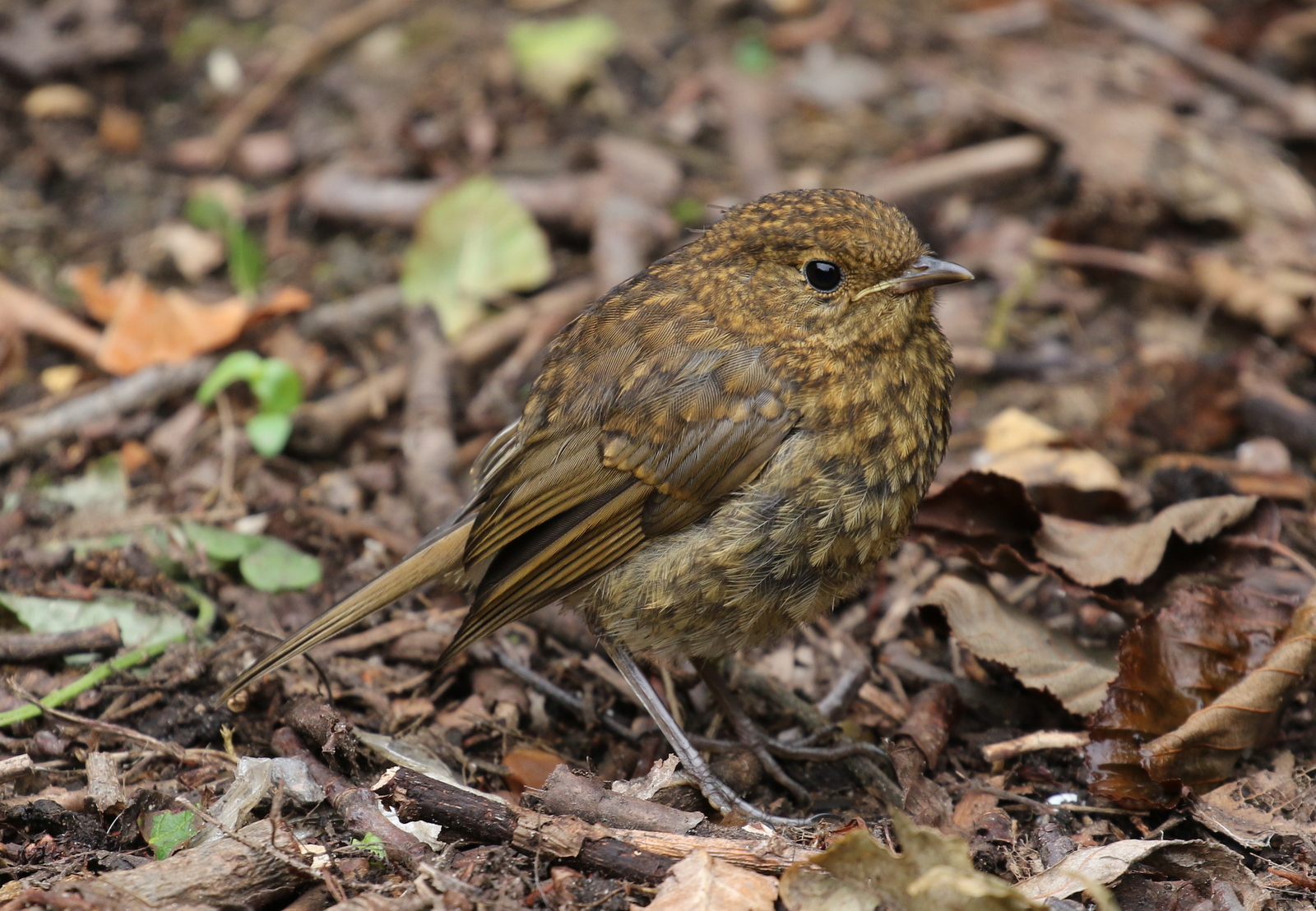 Robin – this juvenile was looking for crumbs around the picnic tables
Robin – this juvenile was looking for crumbs around the picnic tables
We decided to have a look at Patsy’s Reedbed before lunch. As we walked round past Fen Hide, a Hobby flashed past over the reeds and disappeared round behind the trees, the first of several sightings we would get of it today.
There were quite a few ducks on Patsy’s Reedbed today, in particular a good number of Common Pochard. The drake dabbling ducks are all in their drab eclipse plumage now, but we could see there were just Mallard and Gadwall here. There was a single Egyptian Goose too. A couple of stripy-headed juvenile Great Crested Grebes were swimming around the edge of the reeds and there were several Little Grebes too – an adult diving in the pondweed at the back and two drabber juveniles along the bank at the front.
There was quite a bit of juvenile Marsh Harrier action, with several birds flying around over the reeds or chasing each other up over the trees. We got good views of a couple of perched birds which gave us a chance to look at some of the variation in head pattern. One juvenile had a more classic head pattern, with golden orange crown and throat, separated by a dark mask. Another had an almost all chocolate brown head, with just a patch of golden feathers on the back of its crown.
 Marsh Harrier – a juvenile, all dark with a golden yellow-orange head
Marsh Harrier – a juvenile, all dark with a golden yellow-orange head
It was time for lunch now, so we walked back, stopping briefly by the dragonfly pool. A Southern Hawker was flying around over the reeds. It looked odd at first, bright rusty orange, until we realised it had caught a butterfly and was in the process of eating it, discarding the wings when it was finished. There were several Common Darter here too.
A young Blackcap, with a rusty brown crown, came up out of the reeds and flew up into the edge of the trees. There were a couple of Reed Warblers in here too and we got nice views of one of them when it flew back into some brambles and started climbing around in the top, looking for insects.
After lunch back in the picnic area, we headed out to explore the rest of the reserve. As we walked down the main path, we heard a Bearded Tit calling nearby and just caught the back end of it as it dived into the reeds. It didn’t reappear, but thankfully we would see several more today. The reedbed pool held a few Mallard, with a single Tufted Duck diving in between them. An adult Great Crested Grebe was sleeping on the edge of the reeds at the back.
Another Hobby shot across the reeds and headed out over the saltmarsh, flushing a variety of birds out of the vegetation. A flock of about 15 Curlew appeared from nowhere and flew round before dropping back into the purple sea lavendar out of view.
As we walked up towards Island Hide, we could hear more Bearded Tits calling and we saw a couple of long-tailed birds zipping over the reeds before dropping down out of view. Thankfully, some of this year’s juvenile Bearded Tits have been showing very well in recent weeks on the edge of the reeds just before the hide, so rather than try to see them in the thicker part of the reedbed, we made our way along to the edge of the freshmarsh.
Sure enough, there were the Bearded Tits. We stood and watched them for a while. We could see at least five tawny coloured juveniles, climbing around the base of the reeds and occasionally hopping out onto the mud in full view. It is great to see them like this and we had some cracking views of them, especially through the scope.
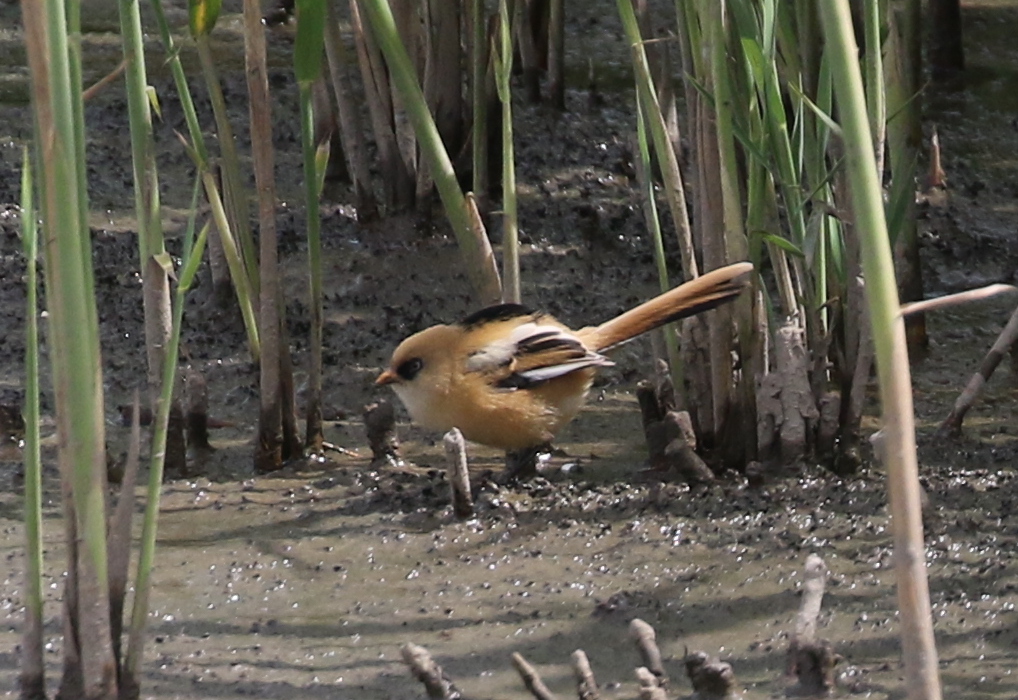 Bearded Tit – at least 5 juveniles were showing very well on the edge of the reeds
Bearded Tit – at least 5 juveniles were showing very well on the edge of the reeds
There was one other bird we really wanted to make sure we saw here today so, after watching the Bearded Tits for a while, we made our way straight round to the other side of Island Hide. The adult Pectoral Sandpiper was in its usual place, on the mud right below the path. It has been delighting visitors with fantastic close up views here for several days now and we were not disappointed.
Pectoral Sandpiper is an occasional visitor here. They breed in the arctic in eastern Siberia and North America, with most of the population wintering in South America, so this one was a long way from home. Pectoral Sandpipers are small waders, not much bigger than Dunlin, with a heavily streaked breast sharply divided from a white belly, the curved border between which is the pectoral band from which it gets its name.
 Pectoral Sandpiper – showing extremely well on the mud by Island Hide
Pectoral Sandpiper – showing extremely well on the mud by Island Hide
While watching the Pectoral Sandpiper, it was difficult not to get distracted by all the other waders out on the freshmarsh at the moment. It may be summer to us, but it is already autumn for many waders. They have already come back from their arctic breeding areas and gathering here to moult or feed up before continuing further south.
There were several Ruff feeding close to the bank. The males have already lost their distinctive ruffs which they have in breeding plumage and are in the process of moulting their body plumage, losing their bright and gaudy colours. At this stage, they come in a truly bewildering variety of different colours, a major source of confusion to the unaware.

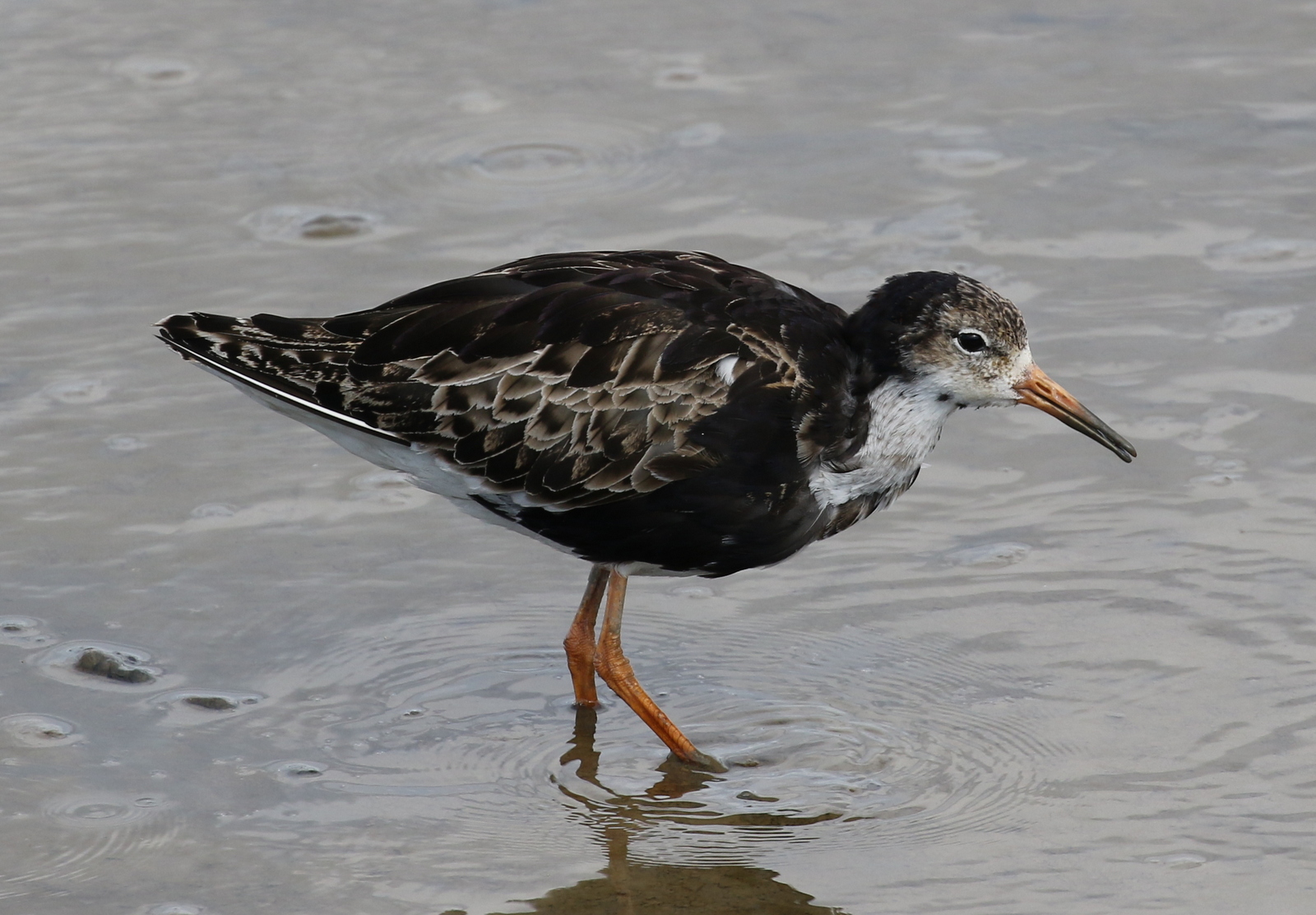
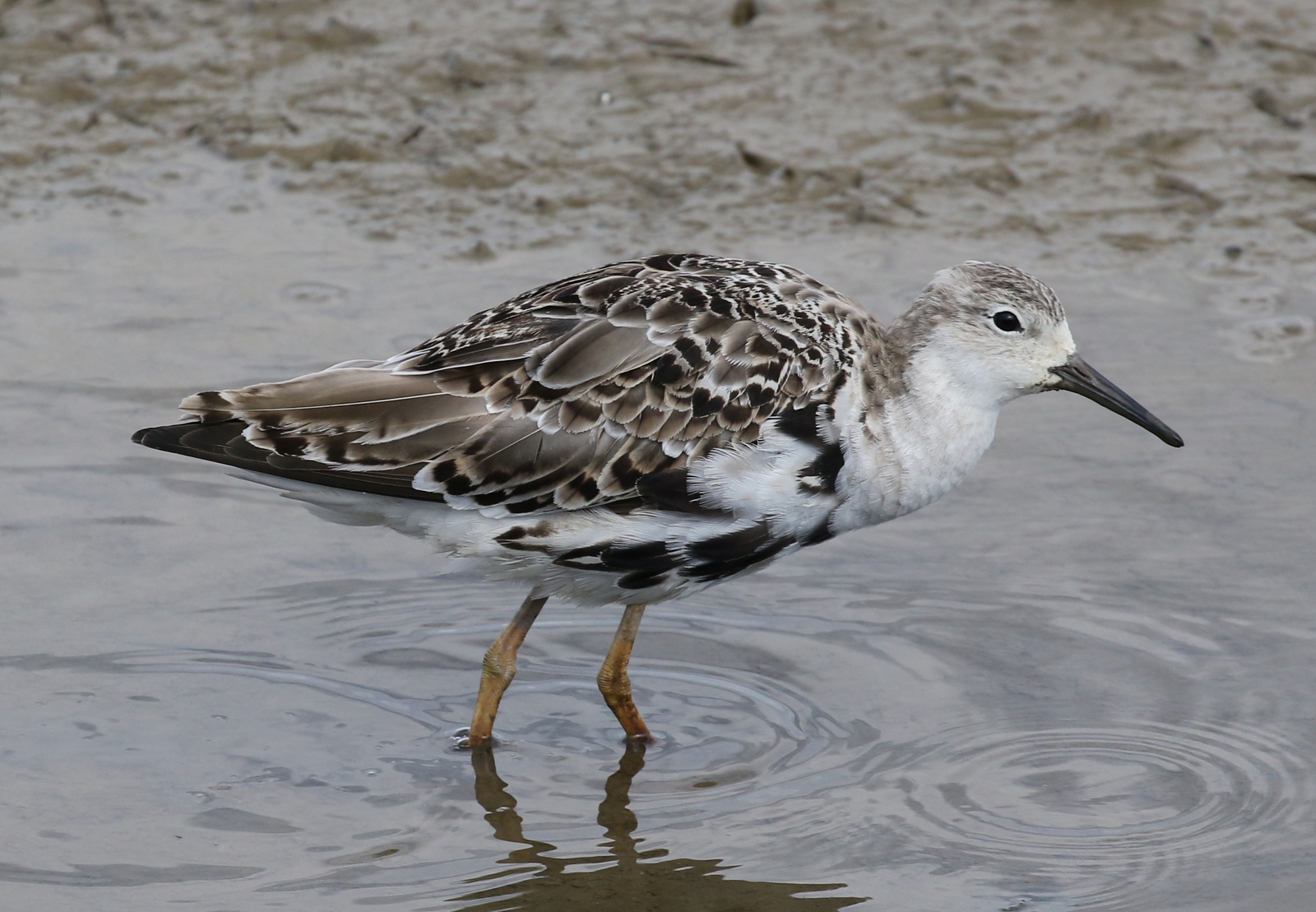 Ruff – moulting out of breeding plumage, in a huge variety of different colours
Ruff – moulting out of breeding plumage, in a huge variety of different colours
In with them were a couple of female Ruff, also traditionally known as ‘Reeves‘. They are much smaller than the males and not as brightly coloured, meaning yet more potential confusion!
A line of Bar-tailed Godwits, roosting on the freshmarsh while high tide covers the beach where they typically feed, were mostly in grey winter plumage, although two summer males in with them were still bright rusty red. There were several groups of Black-tailed Godwits too, feeding in the deeper water at the back or sleeping on the islands.
There were other waders dropping in here all the time, birds on the move, just arriving back from the continent. A Whimbrel dropped in amongst a flock of Oystercatchers on the edge of one of the islands, stopping to bathe and preen before disappearing again. A small group of six Golden Plovers flew in and landed briefly, before carrying on west.
There had been a Curlew Sandpiper reported earlier, but we couldn’t find it in with the small flocks of Dunlin on here. Then a juvenile Lesser Black-backed Gull flew in and started flying round over the scrape, flushing all the waders, the Avocets being particularly jumpy, taking to the air at the slightest hint of danger and swirling round in a big flock. There have been close to 500 Avocets on the freshmarsh in recent days, both birds which have bred here and others which have come here to moult.
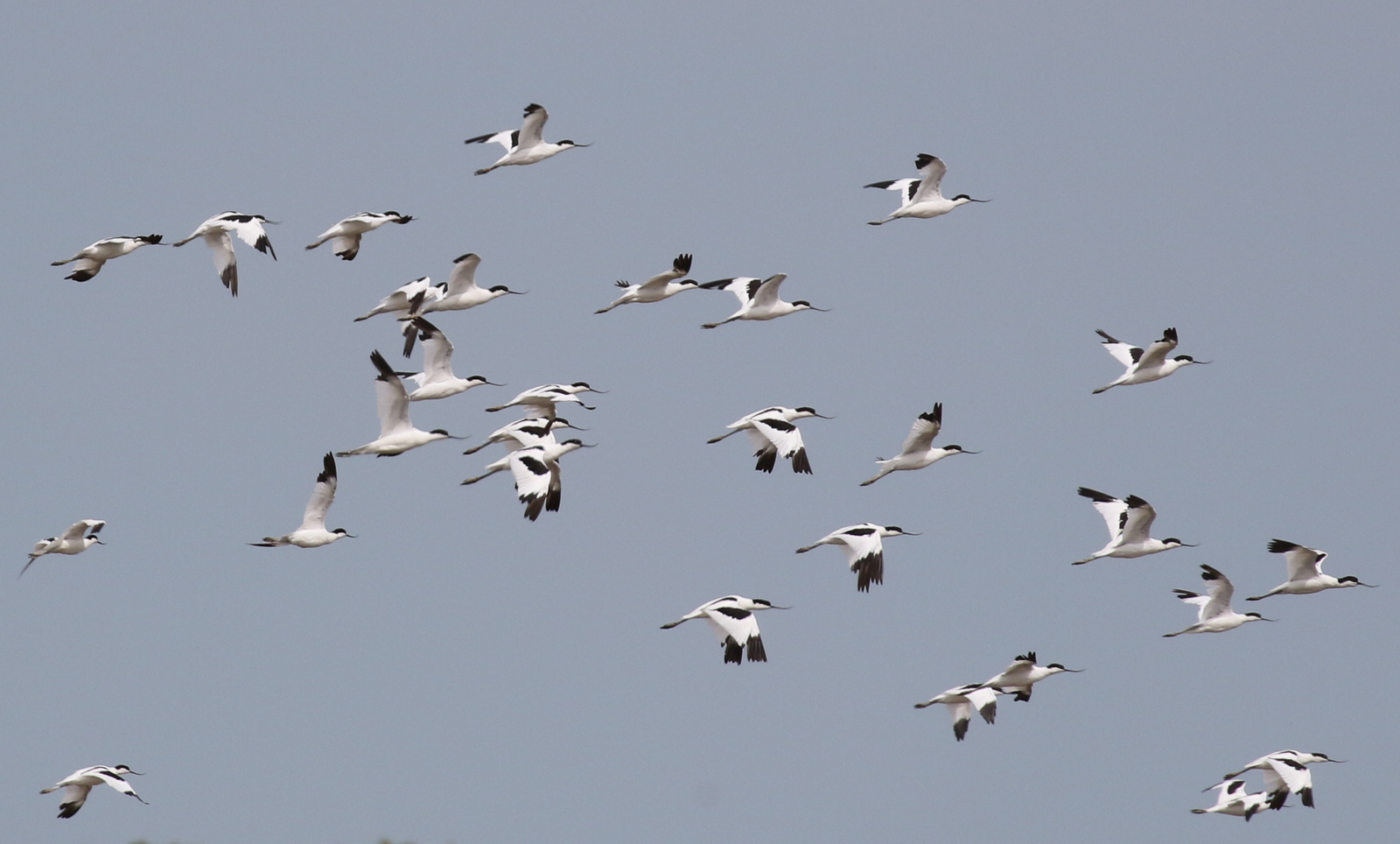 Avocets – swirling round in a huge flock at the slightest hint of danger
Avocets – swirling round in a huge flock at the slightest hint of danger
As things settled down again, it was clear all the Dunlin had flown off. The Spotted Redshanks settled back down though, and the more we looked, the more we found. There were at least five here today, probably more. They are all moulting adults, all already having lost much of their black summer plumage, with some mottled and one already almost in silvery grey winter plumage. A few Common Redshanks were out the other side of Parrinder Hide.
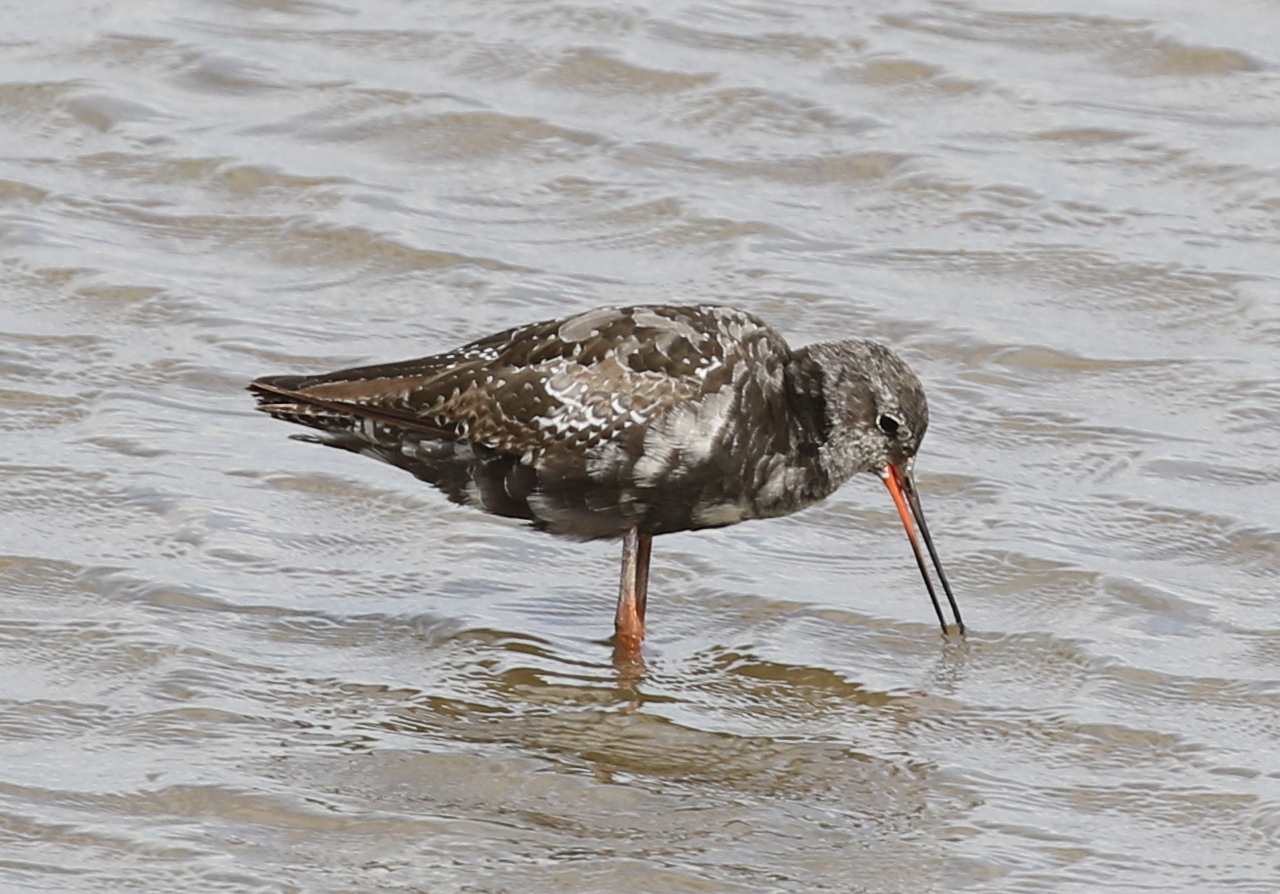 Spotted Redshank – moulting out of its black summer plumage
Spotted Redshank – moulting out of its black summer plumage
A small group of Turnstone flew in, presumably pushed off the beach by the rising tide. A couple were still in pristine breeding plumage, stunning birds with white faces and bright chestnut feathers in their upperparts. A lone Common Sandpiper on the tern island was another migrant on its way south, but the juvenile Little Ringed Plovers had probably been raised on site here.
The Spoonbills were hiding around the far edge of the small overgrown island at the back of the freshmarsh at first. They were doing what Spoonbills like to do best – sleeping! We could see 4-5 large white shapes. When the gull buzzed the freshmarsh and spooked all the waders, the Spoonbills woke up and shuffled to the edge of the island. We could now see there were actually eight of them.
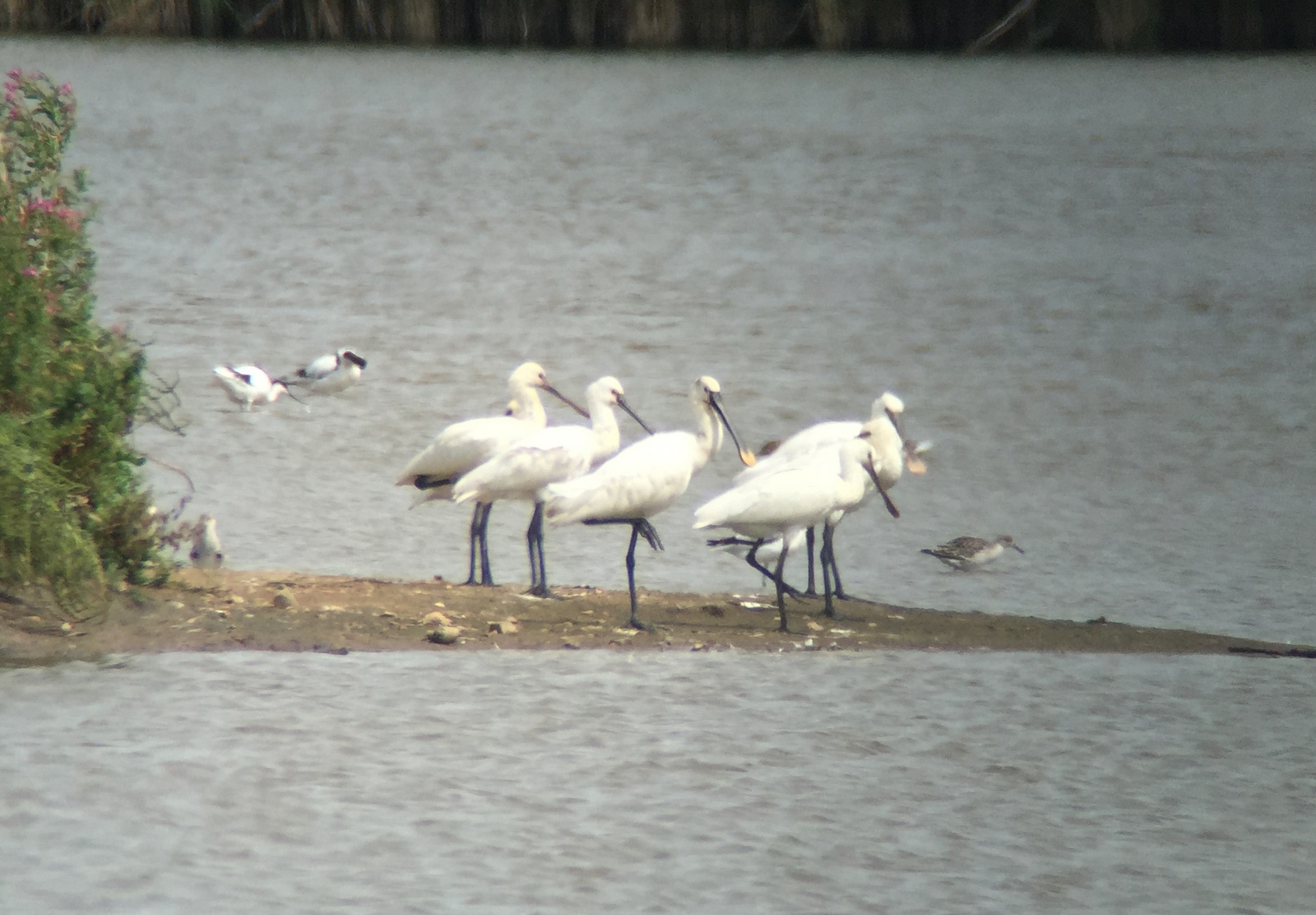 Spoonbills – at least 8 were sleeping round the back of the small island
Spoonbills – at least 8 were sleeping round the back of the small island
There were Spoonbills coming and going too. First, one flew in from Thornham saltmarsh but continued straight on past the freshmarsh. Then another flew in from the same direction, but this one circled round and dropped down onto the edge of the island with the others. Then two of the group took off and flew straight towards us, passing over our heads before continuing on towards Thornham Harbour. They were immatures, with black wing tips still.
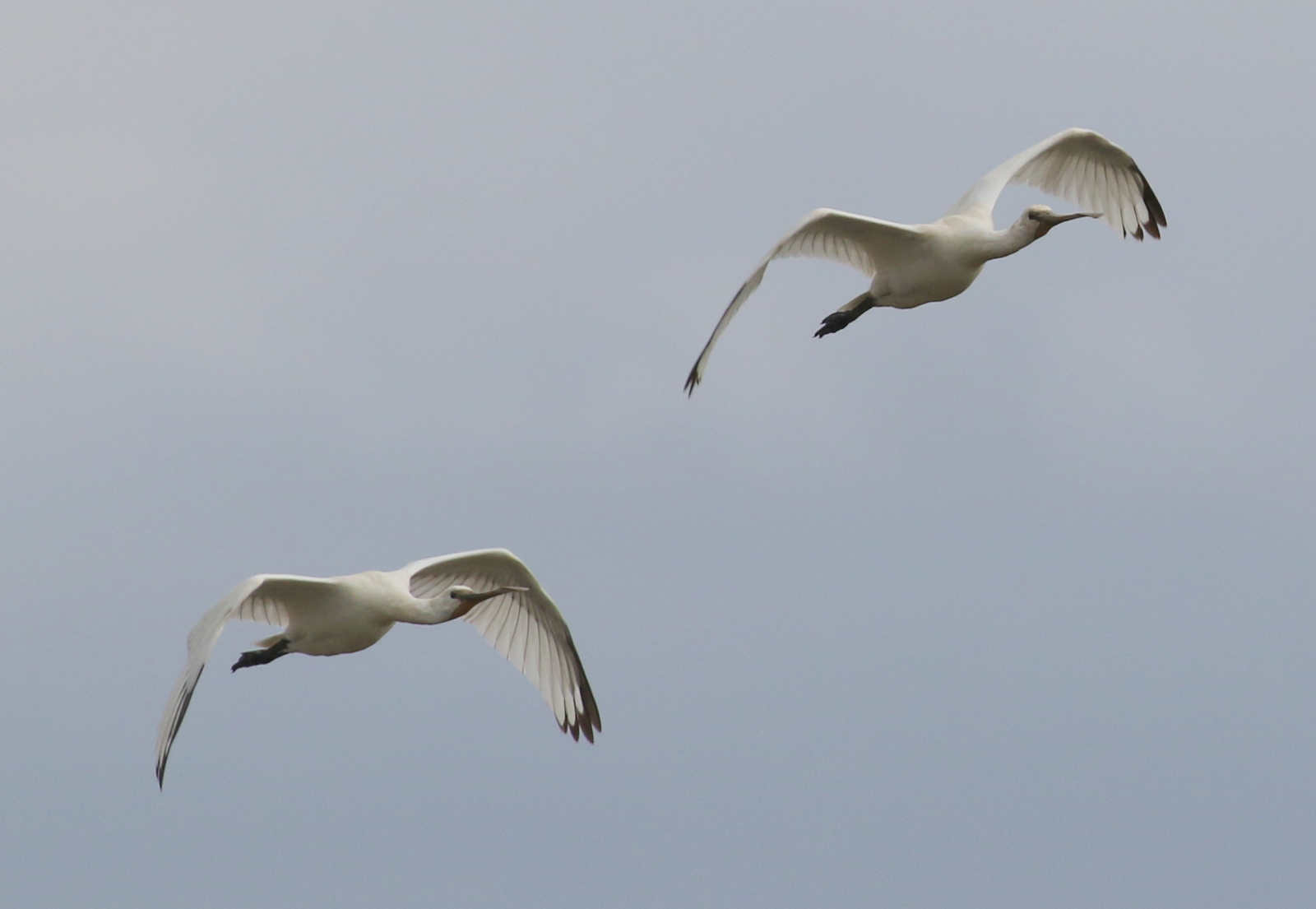 Spoonbill – these two flew off over our heads and out towards Thornham Harbour
Spoonbill – these two flew off over our heads and out towards Thornham Harbour
There are lots of gulls and terns on the freshmarsh too at the moment. Lots of Black-headed Gulls have bred here and there were numerous brown-backed juveniles sitting around on the islands. Occasionally, they would find one of their parents and start hounding them for food, begging. Typical teenagers! About nine pairs of Mediterranean Gulls have bred here this year, in with the Black-headed Gulls. There are several juvenile Mediterranean Gulls around at the moment, very smart and distinctive birds with their scalloped upperparts.
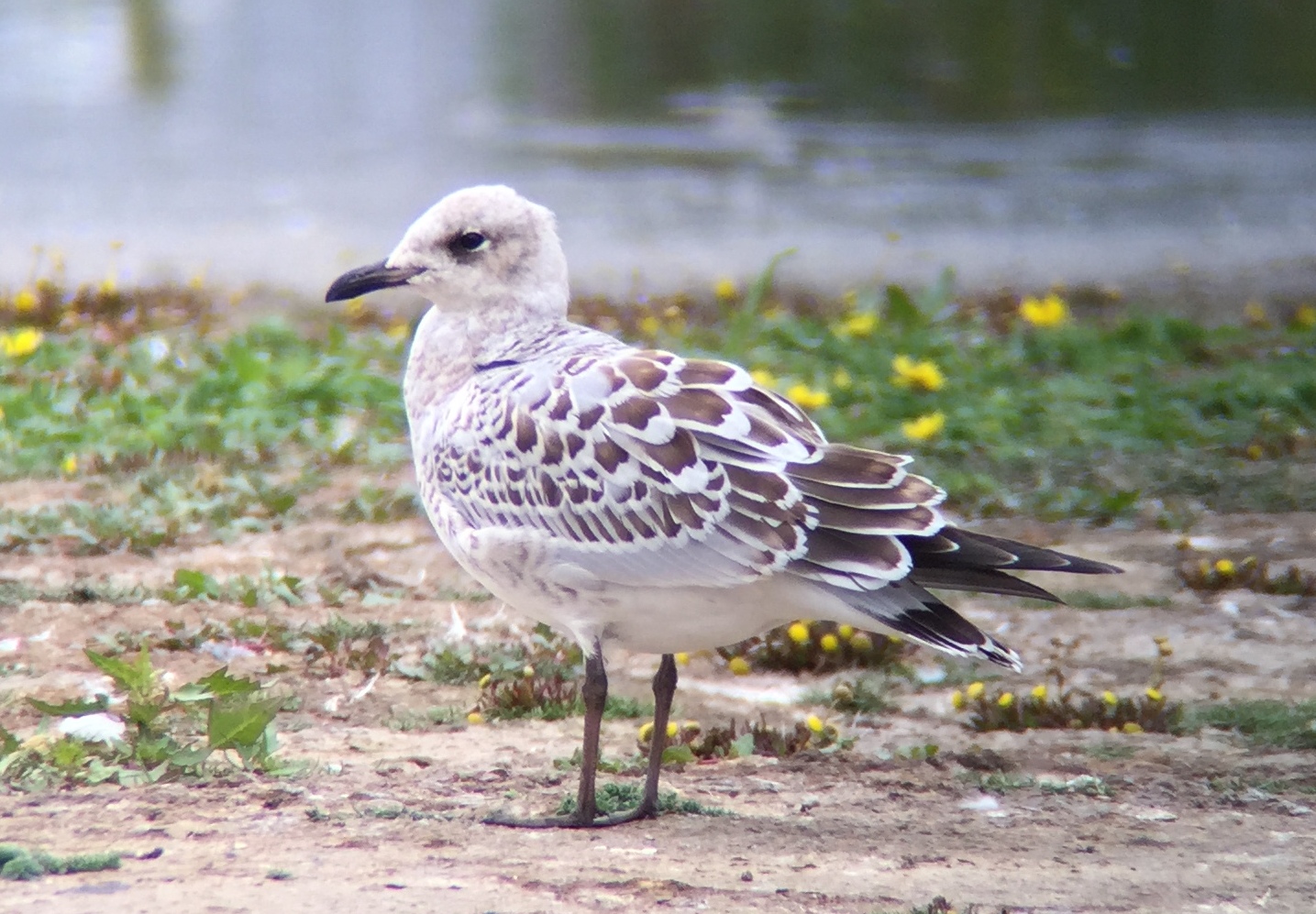 Mediterranean Gull – a smart juvenile, just starting to get a few fresh grey feathers
Mediterranean Gull – a smart juvenile, just starting to get a few fresh grey feathers
There have been a few Little Gulls around the freshmarsh for some time now. Eventually we found two of them today, one rather more uniform pale grey above, the other with quite extensive black in the wings and a darker head. Both were first summer birds. There were several Common Terns around the islands too.
We could see dark clouds building to the south, so we decided to make a quick dash for the beach.The tide was already covering the mussel beds when we got there and there were no waders left on the sand. There were lots of white shapes flying back and forth or diving offshore – Sandwich Terns. A smaller tern patrolling back and forth just the beach was a Little Tern. A couple of distant Gannets flew past, but there was no sign of any Arctic Skuas now. We had one eye on the weather and, at this stage, we decided discretion was the better part and bade a quick getaway, back to Parrinder Hide.
As it was, the rain passed to the west of us and we got no rain at Titchwell at this stage. It was woryhwhile coming into the hide anyway. Many of the birds were the same as those we had seen earlier from the main path. However, we were just commenting on how there were no Dunlin here now, when three small waders flew in together. Two of them were Dunlin, but the third was larger and flashed a white rump as it landed. It was a very smart adult summer Curlew Sandpiper, still with mostly rusty chestnut underparts. It started feeding, working its way in and out of the Bar-tailed Godwits, wading in up to its belly in the water.
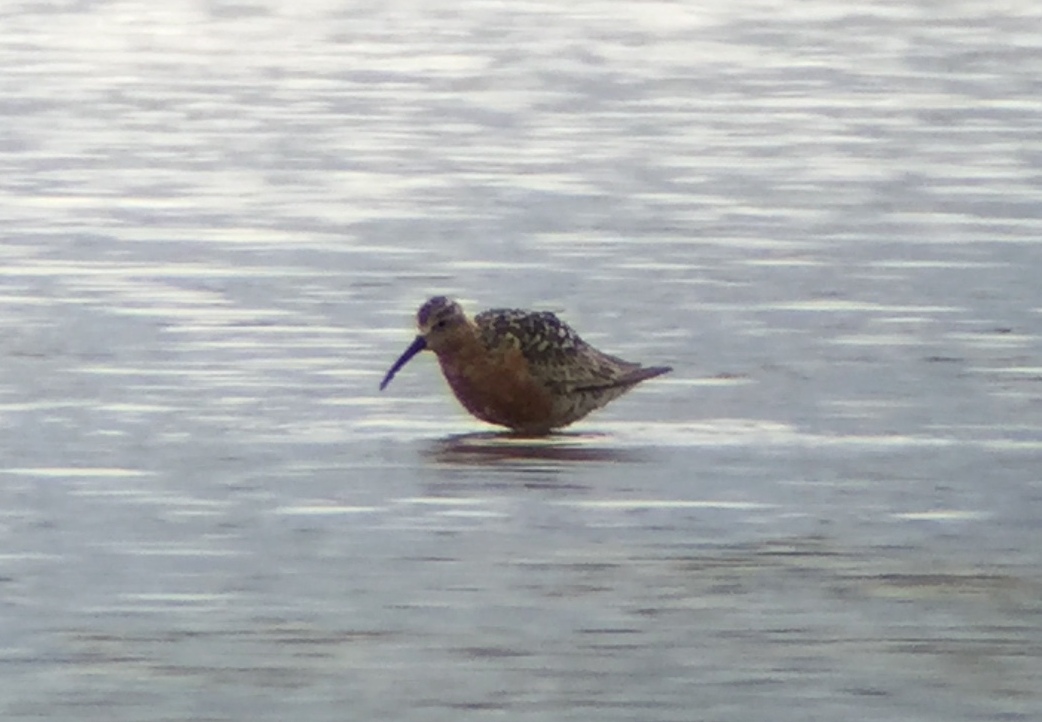 Curlew Sandpiper – dropped in to the freshmarsh with two Dunlin
Curlew Sandpiper – dropped in to the freshmarsh with two Dunlin
We looked back along the near edge, out to the east of Parrinder Hide and were thrilled to see a single Common Snipe. Unfortunately it didn’t stay put for long, but was chased by one of the local Moorhen. The Snipe flicked up but quickly landed again, adopting a threat posture, bowing down and lifting its tail to flash to its aggressor. Pretty quickly, something spooked it and it flew off.
It was time to head back now anyway, but with more dark clouds approaching from the south, we could see it was raining beyond. We walked briskly back to the car, encountering just a small amount of light drizzle before we got back, just in time. It started to rain properly as we loaded up the car, and we then drove into torrential rain. But it didn’t matter now, at the end of the day. Overall, we had been very lucky with the weather – it had been a great day, with some great birds.
















